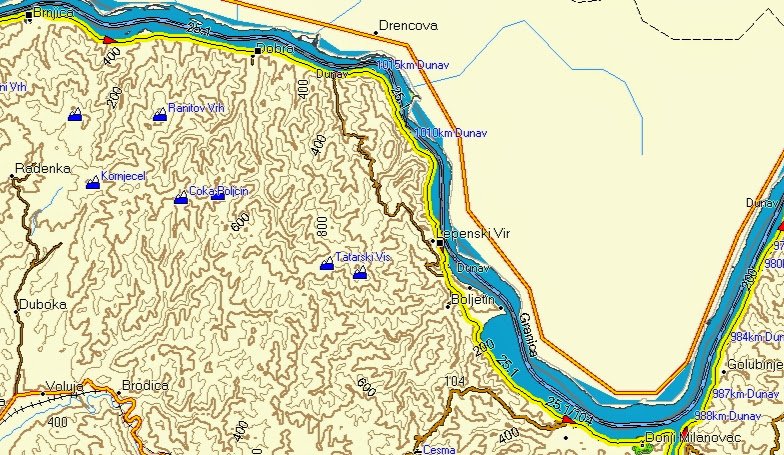
Beside birds, in this park you stand a chance of spotting the Eurasian Lynx, Brown Bear and Gray Wolf! Well, do you really? I was about to say that I haven’t seen any of these in the wild (only tracks of Bear and Wolf in the snow, but not in this park) and then I remembered one Serbian ornithologist who often visited this area and once, while driving through the forest in the night, had the most elusive of the trio – the Lynx – framed in his headlights. So, yes – it is possible, but by no means easy.
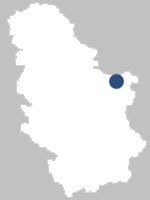 Even among the protected areas of Serbia, the Iron Gates National Park (in Serbian: Djerdap) stands out as better preserved. About 70 per cent of the park area is covered by broadleaved forest (mostly beech and oak) and scrub, while the rest are meadows and orchards, limestone cliffs, boulders and scree, and the rivers. The national park ranges some 100 km in length along the right bank of the Danube (the left bank is in Romania), where the river varies in width from 5 km / 3 mi to only 150 m / 500 ft and the mountains rise up to 800 m / 2600 ft a.s.l.
Even among the protected areas of Serbia, the Iron Gates National Park (in Serbian: Djerdap) stands out as better preserved. About 70 per cent of the park area is covered by broadleaved forest (mostly beech and oak) and scrub, while the rest are meadows and orchards, limestone cliffs, boulders and scree, and the rivers. The national park ranges some 100 km in length along the right bank of the Danube (the left bank is in Romania), where the river varies in width from 5 km / 3 mi to only 150 m / 500 ft and the mountains rise up to 800 m / 2600 ft a.s.l.
Practicalities: The riverside town of Golubac (130 km / 80 mi or two hours’ drive from Belgrade) is the entrance point to the area. It is possible to reach it on the Friday afternoon, sleep there and go birding at the crack of dawn on Saturday. Almost every village between Golubac and the next town of Donji Milanovac (a further 60 km / 40 mi) offers rooms to let, but petrol stations are to be found only in the towns.
Hiking routes and forestry tracks passable for mountain bikes and 4x4s aside, there are very few roads in the national park (which partially explains why it is so well conserved). Keep in mind that the special nature reserves (dark green on the park map) enjoy the highest level of protection and are off limits to visitors (possible only with research permits issued by the park authorities). The Iron Gates consist of several consecutive gorges and is most easily divided to the Upper and the Lower Gorge, upriver and downriver from the town of Donji Milanovac (where the park HQ is).
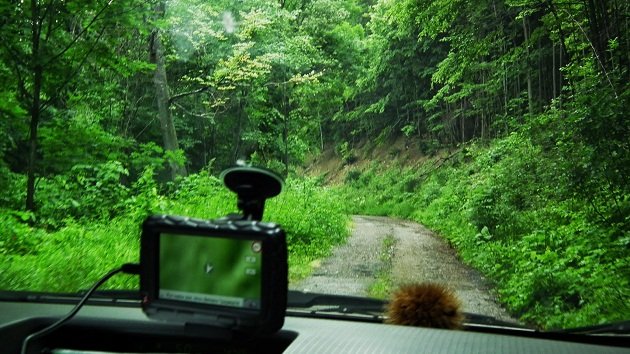 The Forgotten Road does not exist on the GPS screen either.
The Forgotten Road does not exist on the GPS screen either.
Birds of the Iron Gates: While the best birding season here is the breeding period (May to June), the Iron Gates is also an important migratory stopover and wintering area. So far, about 170 bird species have been recorded in the park, including European Honey Buzzard, White-tailed, Short-toed Snake, Lesser Spotted, Golden and Booted Eagles; Northern Goshawk, Black Kite, Peregrine Falcon, Hazel Grouse, Corncrake, Stock and European Turtle Doves; Eurasian Scops, Eurasian Eagle and Ural Owls; Alpine Swift, Grey-headed, White-backed, Middle Spotted and Lesser Spotted Woodpeckers; Woodlark, Eurasian Crag Martin, Red-rumped Swallow, White-throated Dipper, Collared Flycatcher, Sombre Tit, Red-backed Shrike, Woodchat Shrike and Rock Bunting. In winter, try to bird the “Golubac Sea” (scope necessary), where good species include Smew, Velvet Scoter and Common Eider; while the cliffs and quarries near the mediaeval Golubac Fortress offer the elusive Wallcreeper (which still eludes me, although I’ve tried this area last winter).
The Forgotten Road route: To a birder discovering this area for the first time, I would advise you focus on the closer and more gently undulating Upper Gorge (the slopes of the Severni Kucaj mtns). My suggestion is the 20 km / 12 mi long section of once upon a time the main regional route (driving along it, you will find this hard to believe). When the new road was built somewhere in the 1970s, this one has all but disappeared from the maps, memories and the local municipality road repairs budget. It is an asphalt road, but I seriously doubt that it was resurfaced any time in the last 40 years.
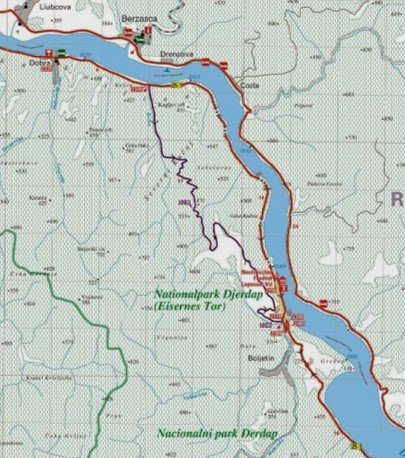 Purple – the Forgotten Road
Purple – the Forgotten Road
Red – the main road
Green – the national park border
In some sections (closer to the village of Boljetin), the asphalt is surprisingly well preserved, in other sections there are more potholes than the asphalt, and lastly, there are sections where the surface has been reduced to pebbles. Am I complaining about it? No! The condition of it keeps the weekend crowds away. At the same time, the Forgotten Road is easily navigable for low clearance cars at low speed and the ideal birding speed is 30 km/h / 20 mi/h anyway!
The Forgotten Road route connects the villages of Dobra (155 km / 95 mi from Belgrade) and Boljetin, passing through dark and old beech forests, and further south, through meadows interspersed with oak groves and orchards. The high humidity in the gorge, further increased 45 years ago with the construction of the Iron Gates Dam, has turned usual altitudinal vegetation zones upside down. In the foothills zone, where normally oak grows, here we find the beech which is looking for cool, damp and shady conditions, while the oak forests are to be encountered on warmer, sunny hilltops. There are some rooms to let in the Dobra Village itself, at Stanojevic and Cvetkovic homesteads, so it is possible to spend the night there and start birding when you open your eyes.
The turn off from the main road is east of Dobra. Go right after the bridge with bright red railings and follow the international Danube cycling route sign for the Kladovo and the Donji Milanovac. The highest section of the Forgotten Road lies at 500 m / 1600 ft a.s.l, where there is a Y junction, right for the Somrda Reserve (dirt road), left for the Boljetin Village – keep left.
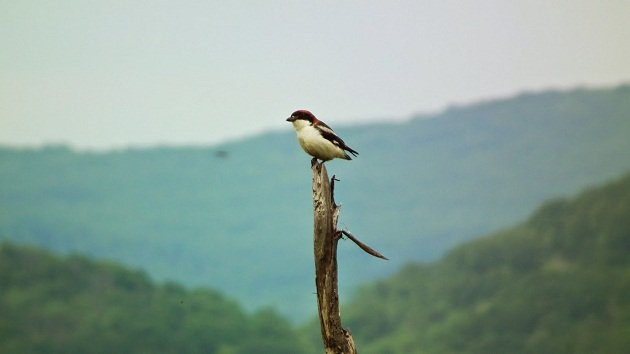 The Woodchat Shrike, Boljetin, June 2014.
The Woodchat Shrike, Boljetin, June 2014.
Birdwise, the Forgotten Road offers European Honey Buzzard, Lesser Spotted Eagle (falling in numbers), Booted Eagle, Corncrake, European Turtle Dove, Eurasian Scops, Ural and Tawny Owls; Black, Grey-headed, European Green, rare White-backed, Middle Spotted and Lesser Spotted Woodpeckers; Woodlark, Red-backed Shrike, and during the visit that has produced this guideblog, in June this year I have recorded the first Woodchat Shrike inside the national park.
 In the afternoon you may visit the Lepenski Vir, an important Mesolithic archaeological site housing a large village with unique stone head-sculptures. Archaeologists have estimated that the number of working hours per week necessary to sustain the Lepenski Vir villagers was only 20 to 25 – we must have taken some very wrong turn in the following 8000 years?!? In the evening you may be back in Belgrade.
In the afternoon you may visit the Lepenski Vir, an important Mesolithic archaeological site housing a large village with unique stone head-sculptures. Archaeologists have estimated that the number of working hours per week necessary to sustain the Lepenski Vir villagers was only 20 to 25 – we must have taken some very wrong turn in the following 8000 years?!? In the evening you may be back in Belgrade.
If you opt to spend two nights in the national park, head the next day towards the town of Kladovo (65 km / 40 mi from the Donji Malanovac and 255 km / 160 mi from Belgrade). East of it, between the villages of Kostol and Mala Vrbica, there is the Mala Vrbica fish farm and Important Bird Area (the fish farm is not operational, hence the entrance is free, without the need to ask for permission). Beside the lakes, do pay attention to the surrounding dry pasture, loess bluffs and shrub vegetation (in winter, check the Danube, too).
Birds of the Mala Vrbica: The local bird list is some 120 species long and includes Red-necked Grebe, Pygmy Cormorant, Black-crowned Night, Squacco and Purple Herons; Little Bittern, Black Stork, Eurasian Spoonbill, Garganey, Ferruginous Duck, Western Marsh Harrier, Northern Lapwing, Black-winged Stilt, Common, Whiskered and Black Terns; European Turtle Dove, Little Owl, European Nightjar, European Bee-eater, possibly European Roller, Hoopoe, Tawny Pipit, Common Sand Martin, Northern Wheatear, Eurasian Penduline Tit, Red-backed and Lesser Grey Shrikes; Spanish Sparrow and Ortolan Bunting.
On your way back, you may try to explore the Lower Gorge and Mt. Miroc.
Summer 2019 update: the Forgotten Trail, my favourite route inside the Djerdap National Park, is totally ruined by heavy lorries full of beech trunks (yes, exploited by the state-owned logging company inside the national park – just try to imagine how I feel about it). The road surface wasn’t repaved in the last few decades, but was fairly good for slow bird drives. Nowadays, there are more potholes, ridges and gullies than road itself (high clearance 4x4s only). Also, trying to bypass loaded lorries on a narrow forest road, instead of merely birding… I give up. That road is no more.
GPS coordinates of the Forgotten Road
- The Dobra turn off from the main road: 44°37’45.92″N, 21°57’34.96″E
- The Boljetin turn off from the main road: 44°32’24.18″N, 22° 1’51.14″E
Recommended books:
- (Bilingual coffee table book): “Ptice Djerdapa/Birds of Djerdap” by B. Grubac, Z. Milovanovic and M. Sekler. Published by the National Park in 2013.
- Serbia, the Bradt Travel Guide by Laurence Mitchell, soon to be published edition 6, 2019 (offers extensive coverage of birding sites by yours truly).
Birding the Forgotten Road (2018 update)
- In September: Birding Balkans: a play in two acts
- In May: Those magnificent places down the Danube
- In October: St. Michael’s Summer
Useful links:
This guideblog was written after the visit to the Iron Gates within the “Birdwatching Belgrade and the Djerdap NP” project run by the Supernatural NGO and financed by the Danube Competence Center. The aim of the project was to evaluate the ecotourism potential of the Serbian Danube and to offer birding as the new tourism product of the area.
In the next guideblog: Where to watch birds in Belgrade.











Leave a Comment